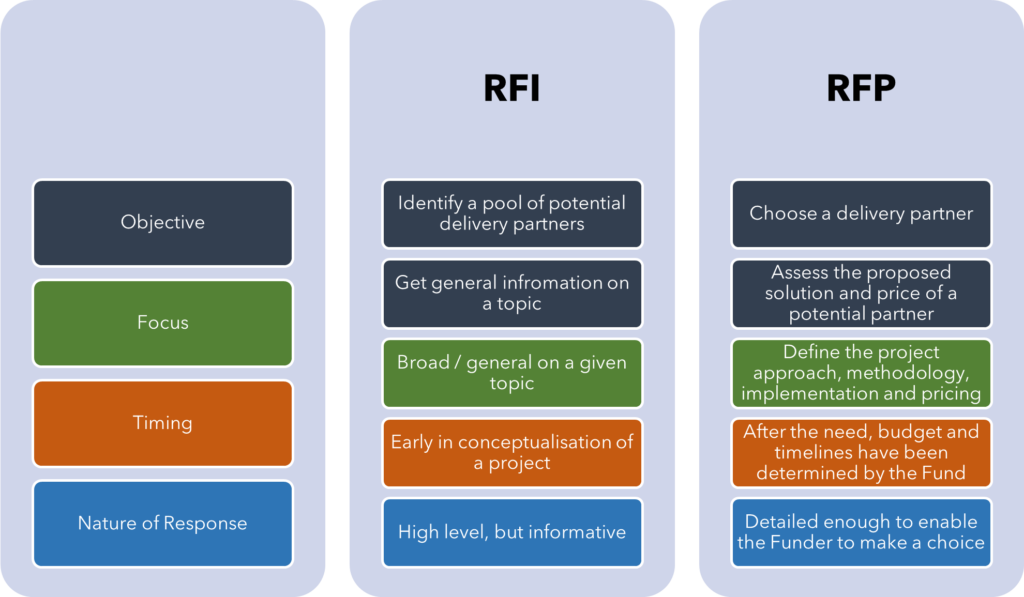C.4 Call for bids and project selection
It is important that the project selection process is objective, fair and transparent. Projects may be (1) initiated or identified by the policy-maker or fund administrator as part of the strategy (such as school connectivity projects); or (2) may be initiated by industry stakeholders such as Internet service providers (ISPs), operators, NGOs, other ministries and consumer groups; or (3) they may also be initiated by project developers. Ultimately, project selection is the responsibility of the fund. The fund may allow applications at specific times, or at any time on an ongoing basis. The details of how eligible applicants can apply for funding must be clearly stipulated in the Fund Manual which should be publicly available.
Fund projects range from community access points and free Wi-Fi to building mobile base stations. These projects will have differing contract terms and will have to address different considerations in the request for proposals (RFP) development and contracting phases, however, the RFP process is broadly the same.
Examples of contract terms and considerations for various project types

Case study: Practical use of the toolkit framework to support the assessment of universal service funded connectivity projects
Over the years, ITU has supported countries to develop, design and revise strategies to implement universal service funds. In 2021, ITU supported the Kenya Communication Authority in conducting an assessment of school connectivity-focused universal service funded projects to support the development of the USF strategy in Botswana.
The ITU universal service financing efficiency toolkit and related assessment frameworks and checklists were used to guide this assessment. The toolkit provides strategic and practical guidance on universal service financing frameworks, USF strategy development and assessment, management, funds utilization/disbursement, and measurement of their effectiveness. The universal service funded school connectivity project was evaluated in terms of economic, social, governance, and environmental sustainability. Case studies from countries around the world are shared in this toolkit as they become available.
The template below is intended to assist the fund or other public financier to choose the projects to pursue and finance, and on what terms. The template is illustrative and can be modified to address the specific project type, and to meet local needs and priorities.
C.4.1 Procurement and selecting vendors
Procurement principles
The USAF and other funders can design project frameworks but are not the implementors of the projects themselves. Funds rely on a range of vendors, suppliers and consultants to deliver the infrastructure and services that are required to bring projects to life. Selecting delivery partners is a critical role of the USAF. It can also potentially turn into a legal challenge if:
- delivery partners are selected that are not able to deliver on time, to specification or by using the correct standards;
- processes used to select them are not fair and transparent.
Projects must provide value for money. The public procurement process design and principles checklist provides an overview of considerations for USAF and other funders to take into account before starting to procure services or equipment from delivery partners.

Public procurement process design and principles checklist
Transparency
✅ Adequate and timely degree of transparency.
✅ Free access for all stakeholders to public procurement information.
✅ Visibility of the flow of public funds.
Integrity
✅ High standards of integrity for all stakeholders in the procurement cycle.
✅ Public sector integrity tools tailored to the specific risks of the procurement cycle.
✅ Integrity programmes for the procurement workforce.
✅ Requirements for internal controls, compliance measures and anti-corruption programmes for suppliers.
Access
✅ Coherent and stable institutional, legal and regulatory frameworks.
✅ Clear and integrated tender documentation, standardised where possible and proportionate to the need (including detailing the procedures that can be used to determine a bidder’s eligibility and ability to perform a specific contract, and providing binding information about evaluation and award criteria and their weights).
✅ Competitive tendering and limit the use of exceptions and single-source procurement.
Balance
✅ Evaluation of the use of public procurement as one method of pursuing secondary policy objectives.
✅ Integration of secondary policy objectives in public procurement systems based on an appropriate strategy.
✅ Impact assessment methodology for measuring the effectiveness of procurement in achieving secondary policy objectives.
Participation
✅ Standard processes when formulating changes to the public procurement system.
✅ Transparent and regular dialogues with suppliers and business associations to present public procurement objectives and to assure a correct understanding of markets.
✅ Opportunities for direct involvement of relevant external stakeholders.
Efficiency
✅ Streamlined public procurement system and institutional frameworks.
✅ Sound technical processes to satisfy customer needs efficiently.
✅ Tools to improve procurement procedures, reduce duplication and achieve greater value for money.
E-procurement
✅ Recent digital technology developments that allow integrated.
✅ e-procurement solutions covering the public procurement cycle.
✅ State-of-the-art e-procurement tools that are modular, flexible, scalable and secure.
Capacity
✅ High professional standards for knowledge, practical implementation and integrity.
✅ Attractive, competitive, and merit-based career options for procurement officials.
✅ Collaborative approaches with knowledge centres.
Evaluation
✅ Periodic and consistent assessment of the results of the procurement process.
✅ Indicators to measure performance, effectiveness and savings of the public procurement system.
Accountability
✅ Clear lines for oversight of the public procurement cycle.
✅ System of effective and enforceable sanctions.
✅ Handling of perceptions in a fair, timely and transparent way.
✅ Coordinated, sufficiently resourced and integrated internal controls, external controls and audits.
Integration
✅ Alignment of procurement processes and information to manage public finance.
✅ Multi-year budgeting and financing to optimise the design and the planning of the public procurement cycle.
✅ Harmonised public procurement principles across the spectrum of public services delivery, as appropriate, including public works, public-private partnerships, and concessions.
Source: Adapted from OECD. Details on each item on the checklist and how to assess them are provided in https://www.oecd.org/governance/procurement/toolbox/search/checklist-implementation-oecd-recommendation.pdf.
Download checklistEfficient procurement: Defining lots
A clear and considered approach to the design of “lots” or groups of beneficiaries should be taken. These lots should be eligible for support as a single project – this applies to infrastructure projects such as connection of clinics or schools. Badly designed lots will increase costs and reduce confidence in the project. Best practice design of lots reduces the risk for the vendors, operators and other project partners. Good design should also facilitate an equitable roll-out and reduce discrimination between institutions, such as clinics and schools, or between locations, such as villages, districts and counties. Lots should be designed based on:
- Facilities located within a single geographic area to facilitate the aggregation of demand, benefit from economies of scale and reduce infrastructure costs. This approach will have the added benefit of facilitating the connection of communities beyond the specific beneficiary facility.
- A single product area, for example, the bulk procurement of devices, so that manufacturing and development costs are kept to a minimum and economies of scale and scope can be leveraged.
It may be more efficient to separate the request for proposals (RFPs) for the provision of connectivity and other parts of the solution such as devices, software and content. Bundling them in a single lot may serve to increase costs. It is critical however, that they are aligned and coordinated so that for example only schools with connectivity receive devices, software and content.
Request for proposals (RFPs)
Once the project has been designed on the basis of robust research, there is a need to identify a vendor or vendors and other delivery partners to provide the requisite services. These services could relate to any aspect of the service such as connectivity, digital literacy and training or consulting on reporting frameworks.
An RFP should specify what is required from the delivery partner. In instances where not enough is known by the USAF or other funders about what it will take to implement the project, a request for information (RFI) may be issued before the RFP. The RFI is more of a fact-finding document than the RFP, which compares proposals from vendors. Issuing an RFI could be useful if insufficient information was gathered at the earlier stages of the project design phase, or if some information is needed that will assist in designing the RFP but is better known to the vendors.

Once the decision has been made to proceed to the RFP stage, it is important that the RFP is clear and contains enough information to enable the respondents to provide comprehensive, well-planned and implementable proposals. The RFP responses will be essential to the selection and contract awarding process (according to the evaluation and award criteria) as well as the conditions and commitments captured in the contracts, against which implementation success will be measured.

Checklist: What to include in an RFP as background information to align all stakeholder understanding of objectives
| Descriptive title | <Insert> |
| Goal | <Insert> |
| Targets | <Insert> |
| Commencement date | <Insert> |
| Duration | <Insert> |
| Target area | <Insert> |
| Beneficiaries | <Insert> |
| Implementation partners | <Insert> |
| Funding partners or source/s | <Insert> |
It is important to note that the project summary template is the basis for the RFP summary, however it excludes budget and cost information so that a competitive bidding process can be used to derive the least cost bid.
In addition, project specific information must be indicated in the RFP as follows:
Outline: Project specific Information to provide to the bidder
| Item | Description |
Scope of work | Overall service requirements. Minimum standards. |
Technical evaluation criteria | A table setting out how the bid will be evaluated (e.g. technical plan – x points, price – y points, project references – z points…). |
Draft service level agreement | Draft of the key clauses of the proposed service level agreement for the successful bidder. |
Administrative and legal requirements | Requirements arising from procurement legislation (e.g. around pricing), funder requirements, etc that the bidder must be aware of and comply with in submitting the bid as well as if awarded the tender |
In addition, a list of all relevant reference documentation should be provided by the project manager to enable the bidder to understand and align the project goals, including:
- relevant national objectives and regional objectives (e.g. broadband policy or digital agenda);
- baseline research / needs analysis;
- mapping;
- forecasting.

Checklist: What to request from the bidder in the RFP
| Item | Description |
|---|---|
Detailed proposal | Overall service requirements Minimum standards |
Cost indication | Costs of delivery of the project as set out in the scope of work. This should not only be a lump sum but should also be broken down into equipment, labour, licensing and other costs. It should also clearly specify capex and opex and payment periods. |
Commencement date and dependencies | Describe start-up requirements/dependencies or lead time required to begin services. |
Site surveys | Copies of the maps and site surveys on which the proposal is based. |
Administration and billing | Describe payment terms and the invoicing process. |
Company information (General) | Capabilities Organizational charts Company history References |
Company information (Project specific) | Capabilities Project organisational chart CVs of key team members |
Describe any additional professional services that may be beneficial to the school/project | This allows the bidder to provide advice on any aspect of the proposed roll-out that they cannot do, and which may have been overlooked by the project team. |
| Examples | India: https://ictschools.ncert.gov.in/wp-content/uploads/2017/08/ICTguide.pdf Rwanda: https://www.unicef.org/rwanda/media/2941/file |
Reference material:
OECD tools for effective procurement Checklist for Supporting the Implementation of OECD Recommendation of the Council on Public Procurement: Participation https://www.oecd.org/governance/procurement/toolbox/search/Checklist%2005%20Participation.pdf
OECD Public Procurement Toolkit https://www.oecd.org/governance/procurement/toolbox/principlestools/ assessment/
